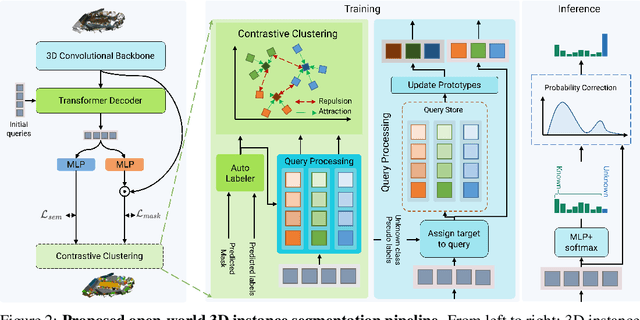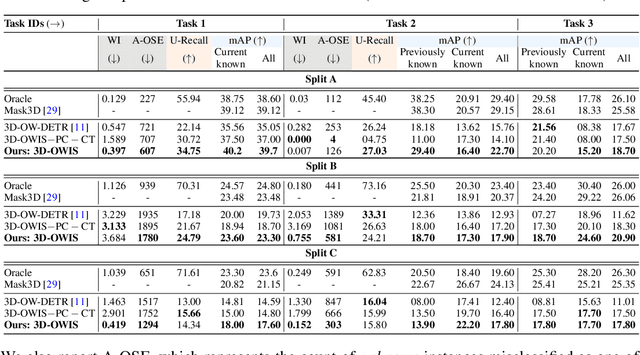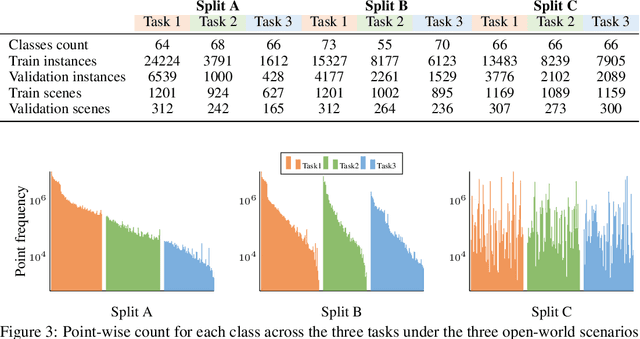Salwa K. Al Khatib
3D Indoor Instance Segmentation in an Open-World
Sep 25, 2023



Abstract:Existing 3D instance segmentation methods typically assume that all semantic classes to be segmented would be available during training and only seen categories are segmented at inference. We argue that such a closed-world assumption is restrictive and explore for the first time 3D indoor instance segmentation in an open-world setting, where the model is allowed to distinguish a set of known classes as well as identify an unknown object as unknown and then later incrementally learning the semantic category of the unknown when the corresponding category labels are available. To this end, we introduce an open-world 3D indoor instance segmentation method, where an auto-labeling scheme is employed to produce pseudo-labels during training and induce separation to separate known and unknown category labels. We further improve the pseudo-labels quality at inference by adjusting the unknown class probability based on the objectness score distribution. We also introduce carefully curated open-world splits leveraging realistic scenarios based on inherent object distribution, region-based indoor scene exploration and randomness aspect of open-world classes. Extensive experiments reveal the efficacy of the proposed contributions leading to promising open-world 3D instance segmentation performance.
PECon: Contrastive Pretraining to Enhance Feature Alignment between CT and EHR Data for Improved Pulmonary Embolism Diagnosis
Aug 27, 2023



Abstract:Previous deep learning efforts have focused on improving the performance of Pulmonary Embolism(PE) diagnosis from Computed Tomography (CT) scans using Convolutional Neural Networks (CNN). However, the features from CT scans alone are not always sufficient for the diagnosis of PE. CT scans along with electronic heath records (EHR) can provide a better insight into the patients condition and can lead to more accurate PE diagnosis. In this paper, we propose Pulmonary Embolism Detection using Contrastive Learning (PECon), a supervised contrastive pretraining strategy that employs both the patients CT scans as well as the EHR data, aiming to enhance the alignment of feature representations between the two modalities and leverage information to improve the PE diagnosis. In order to achieve this, we make use of the class labels and pull the sample features of the same class together, while pushing away those of the other class. Results show that the proposed work outperforms the existing techniques and achieves state-of-the-art performance on the RadFusion dataset with an F1-score of 0.913, accuracy of 0.90 and an AUROC of 0.943. Furthermore, we also explore the explainability of our approach in comparison to other methods. Our code is publicly available at https://github.com/BioMedIA-MBZUAI/PECon.
To Perceive or Not to Perceive: Lightweight Stacked Hourglass Network
Feb 09, 2023Abstract:Human pose estimation (HPE) is a classical task in computer vision that focuses on representing the orientation of a person by identifying the positions of their joints. We design a lighterversion of the stacked hourglass network with minimal loss in performance of the model. The lightweight 2-stacked hourglass has a reduced number of channels with depthwise separable convolutions, residual connections with concatenation, and residual connections between the necks of the hourglasses. The final model has a marginal drop in performance with 79% reduction in the number of parameters and a similar drop in MAdds
 Add to Chrome
Add to Chrome Add to Firefox
Add to Firefox Add to Edge
Add to Edge